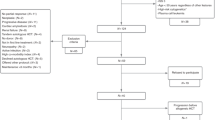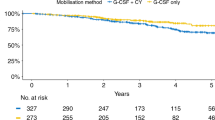Abstract
Prognostic factors for multiple myeloma (MM) after allogeneic haemopoietic stem cell transplantation (alloHSCT) are poorly characterised. Two potential factors include minimal residual disease (MRD) and CD3+ donor-specific chimerism. We retrospectively examined 93 consecutive patients who received upfront or deferred tandem auto-alloHSCT. Bone marrow (Euroflow) MRD was assessed pre-alloHSCT and 3-monthly post-alloHSCT. CD3+ donor chimerism was assessed at D30, D60, D90, 6 m and 12 m post-alloHSCT. There was no statistical difference between upfront and deferred transplants in progression free survival (PFS) (34 m vs. 15 m respectively, p = 0.20) and overall survival (OS) (75.5 m vs. 62.7 m respectively, p = 0.56). Patients who were MRD-positive post-alloHSCT had inferior PFS to MRD-negative patients from 6 m (6 m HR 3.32, p = 0.02; 9 m HR 4.08, p = 0.003; 12 m HR 4.47, p = 0.008). Attainment or maintenance of MRD-negativity predicted reduced relapse risk (23.5% vs. 62.5%, p = 0.04). However, there was no significant difference in OS between the MRD-negative and positive groups. Full CD3+ donor chimerism at early time points (D30 and D90) was associated with increased risk of acute GVHD (D30 p < 0.001, D90 p = 0.006) and extensive chronic GVHD (D90 p = 0.04), but not PFS or OS. These data support the use of sequential MRD evaluation post-alloHSCT to inform intervention to eradicate persistent or emergent MRD-positive disease.
This is a preview of subscription content, access via your institution
Access options
Subscribe to this journal
Receive 12 print issues and online access
$259.00 per year
only $21.58 per issue
Buy this article
- Purchase on Springer Link
- Instant access to full article PDF
Prices may be subject to local taxes which are calculated during checkout






Similar content being viewed by others
References
Fonseca R, Abouzaid S, Bonafede M, Cai Q, Parikh K, Cosler L, et al. Trends in overall survival and costs of multiple myeloma, 2000–2014. Leukemia. 2017;31:1915–21.
Turesson I, Bjorkholm M, Blimark CH, Kristinsson S, Velez R, Landgren O. Rapidly changing myeloma epidemiology in the general population: increased incidence, older patients, and longer survival. Eur J Haematol. 2018;101:237–44.
Aggarwal M, Agrawal N, Yadav N, Verma P, Ahmed R, Mehta P, et al. Autologous stem cell transplantation in first remission is associated with better progression-free survival in multiple myeloma. Ann Hematol. 2018;97:1869–77.
Schönland SO, Iacobelli S, Koster L, Blaise D, Potter M, Cornelissen J, et al. Comparison of different upfront transplant strategies in multiple myeloma - a large registry study from chronic malignancies working party of EBMT. Blood 2019;134(Supplement_1):324. https://doi.org/10.1182/blood-2019-128795.
annual data summary «ABMTRR. http://www.abmtrr.org/index.php/annual-data-summary/. Accessed 28 Mar 2020.
Greipp PR, Miguel JS, Dune BGM, Crowley JJ, Barlogie B, Bladé J, et al. International staging system for multiple myeloma. J Clin Oncol. 2005;23:3412–20.
Moreau P, Cavo M, Sonneveld P, Rosinol L, Attal M, Pezzi A, et al. Combination of International Scoring System 3, highlactate dehydrogenase, and t(4;14) and/or del(17p) identifies patients with multiple myeloma (MM) treated with front-line autologous stem-cell transplantation at high risk of early MM progression-related death. J Clin Oncol. 2014;32:2173–80.
Chng WJ, Dispenzieri A, Chim CS, Fonseca R, Goldschmidt H, Lentzsch S, et al. IMWG consensus on risk stratification in multiple myeloma. Leukemia. 2014;28:269–77.
Jimenez-Zepeda VH, Mikhael J, Winter A, Franke N, Masih-Khan E, Trudel S, et al. Second autologous stem cell transplantation as salvage therapy for multiple myeloma: impact on progression-free and overall survival. Biol Blood Marrow Transpl. 2012;18:773–9.
Lemieux E, Hulin C, Caillot D, Tardy S, Dorvaux V, Michel J, et al. Autologous stem cell transplantation: an effective salvage therapy in multiple myeloma. Biol Blood Marrow Transpl. 2013;19:445–9.
Munshi NC, Avet-Loiseau H, Rawstron AC, Owen RG, Child JA, Thakurta A, et al. Association of minimal residual disease with superior survival outcomes in patients with multiple myeloma: a meta-analysis. JAMA Oncol. 2017;3:28–35.
Rawstron AC, Gregory WM, De Tute RM, Davies FE, Bell SE, Drayson MT, et al. Minimal residual disease in myeloma by flow cytometry: independent prediction of survival benefit per log reduction. Blood 2015;125:1932–5.
Maffini E, Storer BE, Sandmaier BM, Bruno B, Sahebi F, Shizuru JA, et al. Long-term follow up of tandem autologous-allogeneic hematopoietic cell transplantation for multiple myeloma. Haematologica 2019;104:380–91.
Dhakal B, D’Souza A, Martens M, Kapke J, Harrington AM, Pasquini M, et al. Allogeneic hematopoietic cell transplantation in multiple myeloma: impact of disease risk and post allograft minimal residual disease on survival. Clin Lymphoma Myeloma Leuk. 2016;16:379–86.
Lee HC, Saliba RM, Rondon G, Chen J, Charafeddine Y, Medeiros LJ, et al. Mixed T lymphocyte chimerism after allogeneic hematopoietic transplantation is predictive for relapse of acute myeloid leukemia and myelodysplastic syndromes. Biol Blood Marrow Transpl. 2015;21:1948–54.
Huisman C, de Weger RA, de Vries L, Tilanus MGJ, Verdonck LF. Chimerism analysis within 6 months of allogeneic stem cell transplantation predicts relapse in acute myeloid leukemia. Bone Marrow Transpl. 2007;39:285–91.
Mackinnon S, Barnett L, Heller G, O’reilly RJ. Minimal residual disease is more common in patients who have mixed T-cell chimerism after bone marrow transplantation for chronic myelogenous leukemia. Blood. 1994;83:3409–16.
Flores-Montero J, Sanoja-Flores L, Paiva B, Puig N, García-Sánchez O, Böttcher S, et al. Next generation flow for highly sensitive and standardized detection of minimal residual disease in multiple myeloma. Leukemia. 2017;31:2094–103.
Thiede C, Florek M, Bornhäuser M, Ritter M, Mohr B, Brendel C, et al. Rapid quantification of mixed chimerism using multiplex amplification of short tandem repeat markers and fluorescence detection. Bone Marrow Transpl. 1999;23:1055–60.
Dhakal B, Vesole DH, Hari PN. Allogeneic stem cell transplantation for multiple myeloma: Is there a future? Bone Marrow Transpl. 2016;51:492–500.
Costa LJ, Iacobelli S, Pasquini MC, Modi R, Giaccone L, Blade J, et al. Long-term survival of 1338 MM patients treated with tandem autologous vs. autologous-allogeneic transplantation. Bone Marrow Transplant. 2020;55:1–7.
Kuiper R, Van Duin M, Van Vliet MH, Broijl A, Van Der Holt B, Jarari L El, et al. Prediction of high- and low-risk multiple myeloma based on gene expression and the International Staging System. Blood. 2015;126:1996–2004.
Bygrave CA, Pawlyn C, Davies FE, Cairns D, Striha A, Hockaday A, et al. Progression free survival below 12 months following stem cell transplant is a hallmark of high-risk myeloma which is associated with inferior overall survival—data from the Ukmrc Myeloma XI trial. Blood 2018;132:122–122.
Lonial S, Boise LH, Kaufman J. How I treat high-risk myeloma. Blood Am Soc Hematol. 2015;126:1536–43.
Gahrton G, Iacobelli S, Björkstrand B, Hegenbart U, Gruber A, Greinix H, et al. Autologous/reduced-intensity allogeneic stem cell transplantation vs autologous transplantation in multiple myeloma: long-term results of the EBMT-NMAM2000 study. Blood 2013;121:5055–63.
López-Corral L, Caballero-Velázquez T, López-Godino O, Rosiñol L, Pérez-Vicente S, Fernandez-Avilés F, et al. Response to novel drugs before and after allogeneic stem cell transplantation in patients with relapsed multiple myeloma. Biol Blood Marrow Transpl. 2019;25:1703–12.
Greil C, Engelhardt M, Ihorst G, Schoeller K, Bertz H, Marks R, et al. Allogeneic transplantation of multiple myeloma patients may allow long-term survival in carefully selected patients with acceptable toxicity and preserved quality of life. Haematologica 2019;104:370–9.
Nair AP, Walker P, Kalff A, Bergin K, Hocking J, Avery S, et al. Adverse impact of high donor CD3+ cell dose on outcome following tandem auto-NMA allogeneic transplantation for high-risk myeloma. Bone Marrow Transpl. 2017;52:839–45.
Donato ML, Siegel DS, Vesole DH, McKiernan P, Nyirenda T, Pecora AL, et al. The graft-versus-myeloma effect: chronic graft-versus-host disease but not acute graft-versus-host disease prolongs survival in patients with multiple myeloma receiving allogeneic transplantation. Biol Blood Marrow Transpl. 2014;20:1211–6.
Kröger N, Zabelina T, Klyuchnikov E, Kropff M, Pflüger KH, Burchert A, et al. Toxicity-reduced, myeloablative allograft followed by lenalidomide maintenance as salvage therapy for refractory/relapsed myeloma patients. Bone Marrow Transpl. 2013;48:403–7.
Author information
Authors and Affiliations
Corresponding author
Ethics declarations
Conflict of interest
The authors declare that they have no conflict of interest.
Additional information
Publisher’s note Springer Nature remains neutral with regard to jurisdictional claims in published maps and institutional affiliations.
Rights and permissions
About this article
Cite this article
Tan, J.L.C., Das, T., Kliman, D. et al. Evaluation of EuroFlow minimal residual disease measurement and donor chimerism monitoring following tandem auto-allogeneic transplantation for multiple myeloma. Bone Marrow Transplant 56, 1116–1125 (2021). https://doi.org/10.1038/s41409-020-01148-y
Received:
Revised:
Accepted:
Published:
Issue Date:
DOI: https://doi.org/10.1038/s41409-020-01148-y
This article is cited by
-
Cellular Immunotherapies for Multiple Myeloma: Current Status, Challenges, and Future Directions
Oncology and Therapy (2022)
-
Outcomes in newly diagnosed young or high-risk myeloma patients receiving tandem autologous/allogeneic transplant followed by bortezomib maintenance: a phase II study
Bone Marrow Transplantation (2022)



